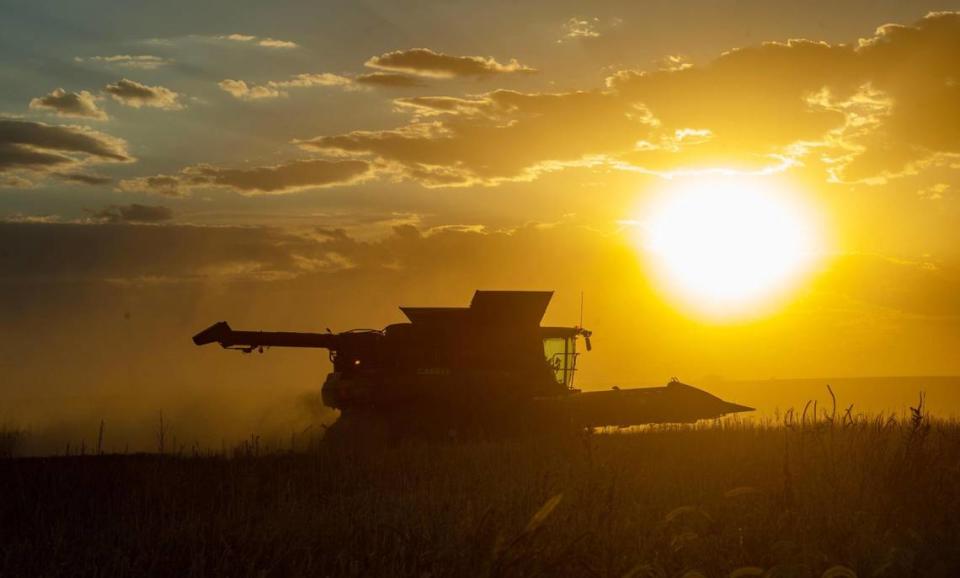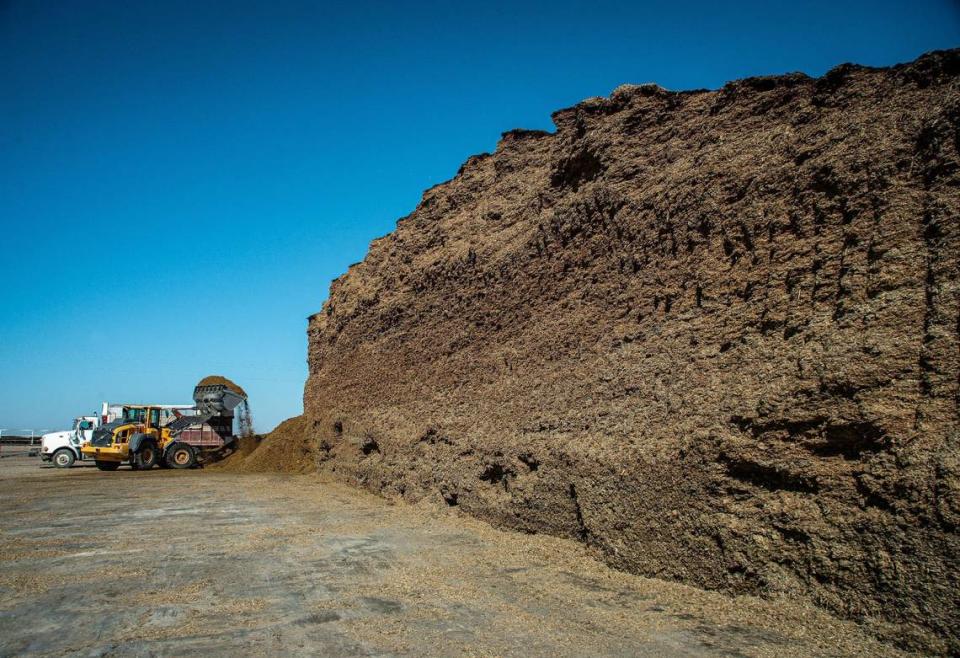Corn is king in western Kansas. Should that change to save an invaluable water source?
The first thing you see when you arrive at Hoxie Feedyard in northwest Kansas is corn.
Roughly 225 million pounds of it sits in a pile so large that it makes the tractors that feed it to 60,000 cattle look like toy trucks.
Corn is the most valuable crop in Kansas – in 2022, farmers collected $3.6 billion from corn, at $7.2 a bushel, according to the U.S. Department of Agriculture. That’s $1.5 billion more than the next highest crop – winter wheat.
For the most part, farmers aren’t growing the sweet corn that you eat on a perfect late-summer evening, salted and dripping with butter. It has other uses.
There’s ethanol, a fuel made often from corn. There’s cornstarch, which is good for your biscuits, but can also be used for dextrin, which has industrial uses like as an adhesive for bookbinding. There’s corn oil, which is good for your potato chips but can also be used to make plastic. There’s corn syrup, which helps jam keep its texture, and high fructose corn syrup, which makes your soda taste good.
And it’s great animal feed.
Scott Foote, the co-owner of Foote Cattle Company in Hoxie, said corn “packs a very powerful punch” nutritionally for cows.
But crops need water to grow. And as farmers fret about the decline of the Ogallala Aquifer, there’s a downside to corn – it has one of the highest water uses of the major crops in high plains. Corn accounts for more than half of the irrigated acres in Kansas: It was grown on more than 1.75 million acres in 2022. The next highest crop, soybeans, were grown on less than 500,000 acres.

For more than half a century, as politicians and officials have failed to meaningfully address the draining of the Aquifer, they’ve all pointed to the same solution – the agriculture community will have to cut back on its water usage. But, in a region that leans heavily on corn and cattle in western Kansas, cutting back would mean changing the agricultural economy.
Corn takes irrigation really well, better than most crops. Researchers at Kansas State University found that if you add an extra inch of water to a corn crop, you can see it result in a higher yield. A higher yield means more money, pushing farmers to use a little more of their water to make a little more money.
Reducing water use while still growing enough to make a profit means changing farming practices – things like better irrigation, genetically enhanced crops that require less water and better weeding and tilling practices. Plus, it requires buy-in from farmers.
“We’re not going to solve this problem with just 15 to 20 percent of producers,” said Weston McCary, a technology projects coordinator at the Kansas Water Office. “It’s an all or nothing thing.”
Often, officials will point to technological advances in farming as a way out of the problem. In a few decades, farmers have gotten smarter not just about how much water they’re using, but how they are watering their crops.
In a demonstration to farmers and farm equipment salespeople on a nearly 100 degree August day, Jonathan Aguilar, a biological and agricultural engineer at Kansas State University, took off his bucket hat and poured a bottle of water on his head.
The water helped, he said, but it will eventually evaporate and he’ll need even more. Then he took a sip of water from a water bottle. It hydrates him and he can sweat off excess water to help keep cool.
Watering a crop closer to its roots is more like giving it a drink. Pour a lot of water over a crop with a sprinkler, and some of that water just evaporates from the leaves and soil, making it less useful. But if you apply the water directly at the base of the crop, you can use less and it’s more efficient.
Aguilar said that while it’s worthwhile to try and move people to more efficient irrigation practices, including convincing people to install high tech machines, it has a limited potential to help – the rest will have to come from crop genetics, weeding and tilling practices.
“That will help them a little bit, I would say, but it’s not a lot,” he said. “Because right now, most of the central pivots are right around 85 to 95% efficient already. So we’re just talking about a 10% improvement, probably on that, in that area.”
Aside from weeding and tilling practices, which also help on the margins, the biggest change could come if farmers are able to find a market for crops that have high value but use less water or are more drought resistant.
Aguilar has talked to farmers in southwestern Kansas about switching to growing cotton – a crop that’s able to grow even in the Sonoran Desert. He said that when corn was already curling during the drought last year, the cotton crop planted by Kansas State University still looked “very healthy and very happy.”
“Cotton is probably one of those crops that they could lean on in terms of reducing the water use,” Aguilar said. “One aspect of it is that it is able to respond to drought conditions better, compared with corn.”
Cotton also has a high tolerance for herbicides, which prevents weeds that steal resources, and it has been modified enough that it can grow in the sometimes cooler regions, like Kansas, compared to where it was traditionally grown.

Scott Foote and his brother Brad are keenly aware of the challenges presented by water quantity. The brothers run Foote Cattle Company and, by extension, operate five feedlots in Kansas and Nebraska as well as several ranches. Several of those properties depend on the Ogallala aquifer.
Feedlots demand corn – a lot of it – which pushes farmers to grow more. While there is more wheat grown per acre, corn has a better yield. In 2022, Kansas farmers averaged 115 bushels of corn an acre, compared to 37 bushels an acre of wheat.
Brant Peterson, who runs Winsome Farms in Stanton County, grows corn as both a dryland and irrigated crop. But he’s also seen a lot of success with his sorghum – he had an award winning yield during a drought year.
He sees possibilities for sorghum as a replacement for corn because it uses less water and is more hearty during a drought. But it becomes more appealing if feed and dairy yards start using sorghum grain as feed instead of corn grain. And that’s not an easy proposal.
The feedlots have the specifications of how much corn to feed their crops down to a science. Introducing a new grain, like sorghum, would require taking a risk. Businesses don’t like risks.
Conservation, Scott Foote said, is a community endeavor. Hoxie Feedyard is a major economic driver for the entire town. If the town is to survive, the feedyard needs to survive and for that, they need to preserve access to their natural resources.
“We were utilizing the grain that the farmers were producing, turning it into beef and thereby upgrading their commodity to a higher level and thereby creating jobs and economic activity. So the farmers were really supportive of how do we work together in this system between feedlot and farm,” Scott Foote said.
It meant buying less water intensive crops from area farmers. Cows also need forages which often take less water. In order to diversify the crops in the area, Foote said, at their economic urging, farmers in the area are producing more forages for the feedlot.
“Our families made very long term investments in our facilities that we had the most to gain to make sure that the aquifer was a resource that can be used for years to come,” Foote said. “On the other hand, we had the most to lose because we need the feed supply every year to feed our cattle.”


